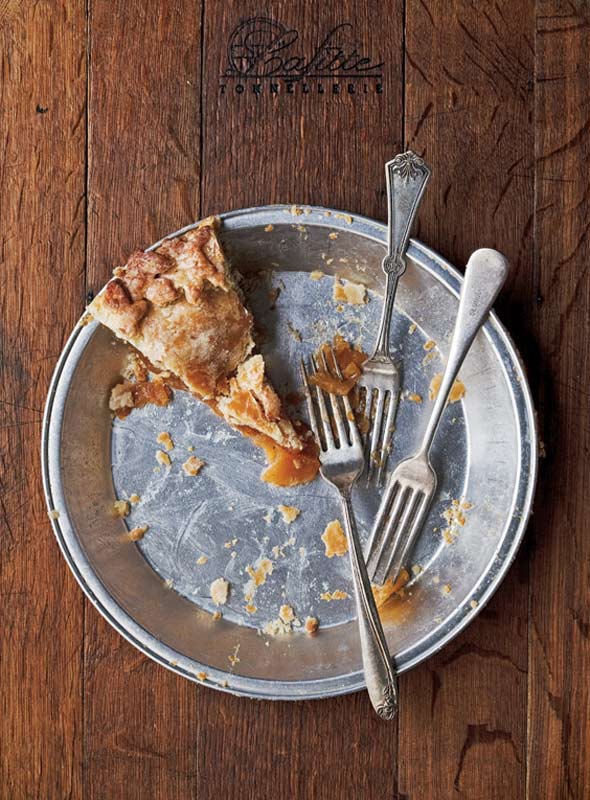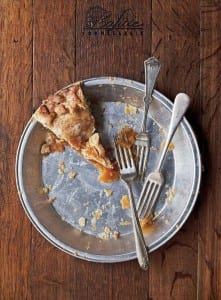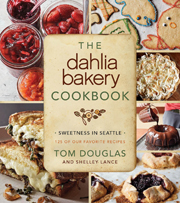
This pastry dough for my apple pie calls for pastry flour, a special flour that you may not already have in your pantry, but the results are well worth acquiring it for a crust that’s both flaky and tender. I prefer unbleached pastry flour, such as King Arthur. If you prefer, you can substitute cake flour for the pastry flour. The pastry or cake flour keeps the pastry dough tender, and the vinegar strengthens the gluten and adds elasticity. This pastry dough has more salt than most. Kosher salt is coarser than table salt. If you are using table salt instead, cut the amount of salt in half.–Tom Douglas
LC Why We Are So Fond Of Tom Douglas Note
Those of you familiar with chef Tom Douglas of Seattle probably already have a pretty darn good idea of why some of us on staff love him so—and have loved him for more than a decade. He’s a swell, down-to-earth guy, not to mention a phenomenal chef and baker. And, in keeping with his genial guy-next-door nature, he’s sharing a few extra tactics that will ensure you end up with perfect pie crust. Here they are:
Want to save this?
For the flakiest pastry, be sure your fats (butter and vegetable shortening) are very cold. Before you start your dough, dice the butter and portion the shortening into a few clumps, place the fats on a plate, then cover with plastic wrap. If you are using the electric mixer method, place the fats in the freezer for 2 hours. If you are using the food processor method, freeze the fats for only 30 minutes (a shorter time because the metal blade has to be able to cut through the butter).
A plastic dough scraper and metal bench knife are useful tools for making pastry dough.

Flaky Pie Crust
Ingredients
- 2 2/3 cups pastry flour
- 2/3 cup all-purpose flour, plus more for the work surface
- 2 tablespoons granulated sugar
- 1 tablespoon kosher salt, or 1 1/2 teaspoons table salt
- 2 sticks unsalted butter, freezer-cold (see LC Note above), cut into 1/2-inch dice
- 1/4 cup vegetable shortening, freezer-cold (see LC note above)
- 1/2 cup ice-cold water, (see LC note above), or more as needed
- 2 teaspoons distilled white vinegar
Instructions
To make the crust in a stand mixer
- In the bowl of an electric mixer fitted with the paddle attachment, combine the flours, sugar, and salt. Add the cold butter and shortening, mixing on low speed until the mixture looks shaggy and the pieces of butter are slightly smaller than peas. Stop the mixer and check the size of the butter, sifting through the mixture with your hands. If you find a few bigger chunks, quickly smear them between your fingers.
- Pour the ice-cold water and vinegar into a measuring cup or small container and stir to combine.
- Add the water-vinegar mixture to the flour-fat mixture in the electric mixer on low speed and mix briefly with a few rotations of the paddle, but do not let the dough come together.
- Turn off the mixer and scrape the sides and the bottom of the mixer bowl to make sure there are no pockets of dry ingredients, rotating the paddle a few more times if needed, then squeeze a small amount of dough in your hand. The dough should come together as a clump. If the dough seems too dry, add a little more water a few teaspoons at a time, and rotate the paddle a few more times.
To make the crust in a food processor
- Put the flours, sugar, and salt in the bowl of a food processor and pulse a few times to combine. Add the cold butter and shortening to the dry ingredients. Use your hands to break up the shortening into several small clumps, being careful to avoid the metal blade, and get the shortening coated with flour.
- Pulse 9 to 12 times. Turn off the machine and take the lid off. The butter should be in pieces a little smaller than the size of a pea. If needed, put the lid back on and pulse a couple more times.
- Pour the ice-cold water and vinegar into a measuring cup or small container and stir to combine.
- Gradually pour the water-vinegar mixture through the feed tube while pulsing 10 to 12 times. Take the lid off. Use your fingers to see if you can clump the mixture together to form a dough. (The dough should not come together to form a ball while you are pulsing it in the food processor, but it should form a clump pressed between your fingers.) Use a rubber spatula to scrape the sides of the food processor bowl and the bottom of the bowl to see if there are any dry pockets of flour. If the dough seems too dry, you can add more water, a few teaspoons at a time, and pulse a few more times.
Knead the dough
- Whether using the stand mixer or food processor method, dump the dough, which will still be crumbly and loose, onto a very lightly floured work surface. Use your hands to work the dough into a cohesive ball, then flatten the ball into a disk. (Note: Because this dough contains pastry or cake flour, which is a soft flour, and because it contains a little vegetable shortening, you can work it with your hands a few times, forming it into a ball and making it cohesive, without having to worry as much about toughening the dough. Feel free to work the dough enough to make it cohesive.)
Shape the dough
- Divide the dough in half and shape it into 2 flattened disks, then wrap each in plastic wrap. Refrigerate it for at least 2 hours or overnight before rolling. (This pastry dough also freezes well for longer storage, but allow it to first rest in the refrigerator for 1 or 2 hours before freezing.)
- When you are ready to roll the dough, unwrap it, place it on a lightly floured surface, and let it rest for 5 to 10 minutes so it’s not quite so cold and stiff. Using a rolling pin, roll the dough out to a round about 12 inches in diameter and about 1/8 inch thick. Transfer 1 round of dough to a 9-inch pie pan. (An easy way to transfer the dough is to fold the dough in half or into quarters. Pick up the folded dough and place it in the pan, then unfold gently, easing—not stretching—it into the pan.) Use your fingers to press the dough lightly against the sides of the pan all the way around so the dough won’t slide down. Trim the excess dough to a 3/4- to 1-inch overhang. Fold the overhang up and over (toward the inside of the pan) and use your hands to press gently on the dough all around the circumference to form a neat pastry rim 1/4 to 1/2 inch thick. (The pastry rim should be flush with the edge of the pie pan and not overhanging it.)
- Fill the pie with your preferred filling, top with the remaining dough round, and press the pastry down against the rim of the pan at about 1-inch intervals to crimp and seal.
Notes
Hand Pies Or Individual Crostata
To make dough for hand pies or individual crostatas instead of a single pie, roll the disks of dough as directed, but cut out individual rounds.
Explore More with AI
Nutrition
Nutrition information is automatically calculated, so should only be used as an approximation.
Recipe Testers’ Reviews
The crust is phenomenal—a bit crunchy, just the right amount of sweetness, and perfectly flaky all, at the same time.










what would you substitute for vegetable shortening? crisco’s no-no. will lard work with *this* pastry flour recipe, or is it suggested/better with the AP flour recipe you linked in comments?
mac, I hear you loud and clear. You know it’s far harder to sell people on lard than it is to dissuade them from using shortening.
I prefer lard myself. It gives the crust such a beautiful flavor and flake. And yes, it will absolutely work in this pastry flour version. In fact, it plays surprisingly well with the softer flour—just be sure it’s cold, and you’ll be golden. That said, it also shines in the all-purpose version, so you’ve got options.
Let me know how it turns out if you give it a whirl—I’d love to hear.
Well, I did it, David. Lard & butter (no vegetable oil). It turned out good, but not perfect. Filling was your Hot Buttered Rum Apple Pie recipe.
Two hurdles are I’m at 5,000 feet elevation & the stove/oven is cousin to Stephen King’s Christine (that demonic ’58 Plymouth Fury).
Using your page/advice on baking high (increase temp 15-25%, decrease time by 5-10 minutes per hour of baking time called for) I adjusted to 400 degrees (~ 15%), reduced the first 30-min bake to 27-min, reduced the second, tented* part of the bake from 60 to 55-min, & reduced the final, untented, 30-min portion to 27-min.
*Do you have an alternative suggestion to tenting with aluminum foil?
Crust was a little over-baked at these settings. But, tent was open on ends, too (I really want away from aluminum in contact with food).
Any suggestions appreciated. This was first pass. Subsequent efforts will dial in closer.
Plus PPTSD (post pie traumatic stress disorder) is now on the run.
Alright, mac, I’ve worked my way through the queue and, as promised, here I am!
I’ve just reread it, and it is every bit as fantastic and funny the second time around. I am absolutely going to find that Seinfeld episode.
Now, pie time. Having the recipe in front of me, I can see exactly what you were up against. It sounds like you were wrestling with two frustrating things: the final result and a stove that belongs in The Exorcist.
So, if I’m reading you right, you’re wondering:
1. What might have made the recipe not turn out “right”?
I’m 99% certain I know the answer. The unique flavor of this pie—the “hot buttered rum” part—comes from the caramel you make at the beginning by melting the white sugar. That dry caramel provides a deep, slightly bittersweet, complex note that balances all the other sweetness.
When your “supernova” burner caused the sugar to “crack hard,” you lost that entire flavor foundation. You save with the maple syrup (trés brilliant, my friend), and I’m sure it was delicious (maple and apple is a classic!), but it’d create a very different pie. It’d be sweeter and miss that complex caramel base.
2. How can we adapt the process for a less-than-cooperative stove?
Your own instinct—”Next time: one pan, one semi-domesticated burner”—is exactly the right solution. Trying to manage two pans on a stove like that is a recipe for disaster. Here’s how you can approach it with one pan:
Work in Batches: Use your largest skillet on your most behaved burner. Cook the apples in two batches. For the first batch, add half the sugar to the pan. Once it caramelizes, add half the apples and cook as directed. Scrape them into a bowl to cool, then repeat the process with the remaining sugar and apples.
Salvation for a Hot Burner (Wet Caramel): A dry caramel (just sugar) like the one in the recipe can burn in a millisecond on a cantankerous stove. A way more forgiving method is to make a wet caramel. For each batch, add a tablespoon of water to the sugar in the pan. The sugar will first dissolve in the water and then begin to boil and color. This slows down the whole process, giving tons more control and preventing it from going from amber to supernova obiteration.
I am confident that with the one-pan, wet-caramel approach, you will nail it. The result will have that deep flavor profile the recipe intends.
Let me know if this makes any sense. I’m dying to see how your next “episode” turns out. Or is this the sasons cliffhanger?